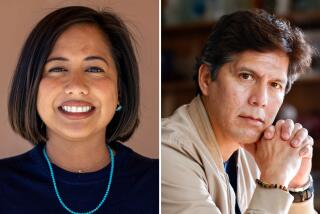Santa Paula Refuses to Change Its Vote System
- Share via
SANTA PAULA — Despite the threat of a federal lawsuit, the Santa Paula City Council voted Thursday night to challenge the Department of Justice’s insistence that the agricultural city switch to a district voting system to give Latinos greater access to elected positions.
“When the IRS sends you a letter that says you owe taxes, there’s not anyone in this room who’s not going to question that,” said Mayor Pro Tem Richard Cook, who told an audience of about 100 that he was part Latino. “If we’re wrong, then Santa Paula has been wrong since it’s been a city.”
In a 5-0 vote, council members adopted a strongly worded 20-page rebuttal to the U.S. Justice Department’s contention that Latinos are being denied fair representation in city elections. The rebuttal was written by Los Angeles voting-rights attorney John E. McDermott, whom the city hired in August for $10,000.
Describing the federal government’s potential legal case “marginal at best,” McDermott dismissed its analysis as “premature, unwarranted and based on incomplete and inaccurate data.”
“The information we and our demographic and statistical experts have assembled . . . does not support the DOJ assertion that Santa Paula’s at-large city council system results in dilution of Hispanic voting rights,” McDermott wrote to acting Assistant Atty. Gen. Bill Lann Lee, a top-ranking department official who oversees the Voting Rights section.
Department officials have postponed filing a lawsuit until after McDermott completed his study and the council decided whether to voluntarily make a change that satisfied the federal agency.
When told that McDermott had advised the city to challenge the Justice Department, Christine DiBartolo, a department spokeswoman, refused to say whether the agency would sue.
“This is still an ongoing matter for us,” DiBartolo said Thursday. “But filing a Section 2 [Voting Rights Act] case certainly would not be the first for us. We’ve brought these cases for many years.”
Councilwoman Laura Flores Espinosa, who had earlier voted against hiring McDermott and instead suggested negotiating with the department, said she believed it was time for the council to band together.
“I offered [my support] as a vote of unity for the city to respond to the Department of Justice,” Flores Espinosa, the only Latino council member, said after the meeting. “We’re asking the department for more information to rationalize a lawsuit.”
The council’s decision capped what has been a tense several weeks as political tensions have escalated between Latino activists and the mostly white council after a yearlong federal probe became public knowledge in August.
In its investigation, the Justice Department found voting patterns that favored white candidates and said Latinos “continue to suffer the effects of a history of official discrimination in voting and other areas.”
Department officials say that single districts, rather than the city’s current at-large system, would give voters in separate geographic areas of the city an opportunity to elect politicians to represent each area.
Switching to five single-member districts would give Latinos--who make up two-thirds of the city’s 27,000 population--the majority vote in two of five districts, department officials maintain.
But in his rebuttal, McDermott argued that Latinos “have had and do have” the ability to elect candidates under the current system, evidenced by the fact that at least one and sometimes more than one Latino has served on the five-member council during the past three decades.
McDermott said Latinos actually have held two of the five seats for 17 of the last 33 years and once controlled the council 3-2, but those statistics rely on an argument that Councilwoman Robin Sullivan is of Latino descent. Sullivan’s father was born in Mexico. But Sullivan, an escrow attorney who does not speak Spanish, was not a preferred candidate of Latino voters.
McDermott also noted that Latinos hold a majority of the seats on both local school boards, which also rely on at-large elections.
McDermott’s study found that Latinos now make up the majority of voting age citizens in Santa Paula, and that Latino political participation is on the rise. Last year, 44% of Santa Paula’s voters were Latino, compared with 31% a decade before, McDermott said.
“That’s a huge jump,” McDermott told the council. “Our strong conclusion is that there is no voting acts violation.”
Waving a 6-foot-long banner that read, “Thank you Justice Department for giving us the opportunity to vote and have our vote respected,” Jesus Linares was among several audience members who disagreed.
“Latinos have not had an opportunity in this town to vote,” said Linares, 74, who lived in Santa Paula in the 1950s and now resides in Oxnard. “Even the polls are too far away from where Latinos live.”
Rodney Fernandez, a 25-year Santa Paula resident, said a district system gives all citizens a greater chance for representation.
“This is an opportunity for you,” he told the council. “It’s like the American Dream, like motherhood and apple pie. It’s an opportunity to increase the democratic process.”
*
Johnson is a Times Community News reporter; Talev is a Times staff writer.
More to Read
Sign up for Essential California
The most important California stories and recommendations in your inbox every morning.
You may occasionally receive promotional content from the Los Angeles Times.










